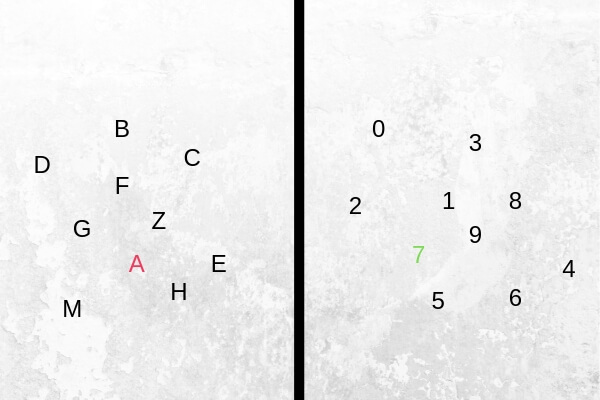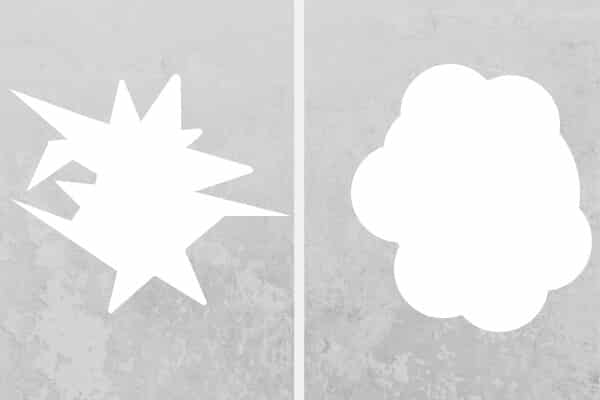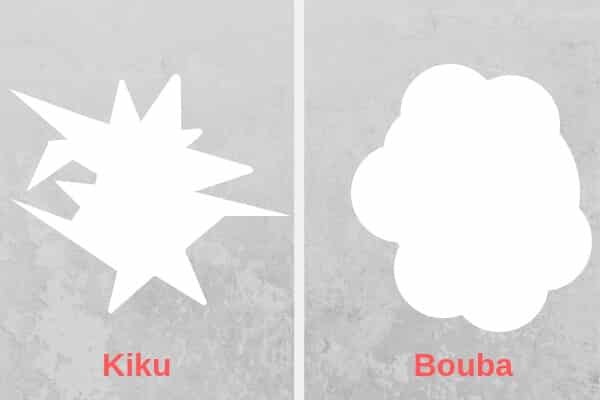What is synesthesia?
Definition:
- Syn=united, combined.
- Esthesia= capacity of sensation, sensibility.
Synesthesia is a medical condition characterized by a ‘blending’ of the senses. For instance, the visual perception of a certain letter might be associated with a color, or holding a particular object might trigger a smelling sensation.
Synesthesia used to be considered rare in the recent past. However, some new studies show that a considerable number of people have this condition including some famous scientists and artists. These people are called synesthetes.
How common is synesthesia?
Prevalence:
The first published paper about synesthesia was in 1880 by Sir Francis Galton, the cousin of Darwin. Not many studies were conducted after that. Hence, the difficulty in determining how common synesthesia is.
The main obstacle revolves around the difficulty to objectify the results of a test subject, but also because many people who have synaesthesia tend to ignore it, especially if the mixed senses are vague or attributed to other stimulating factors. For instance having a bitter taste in your mouth while shaping a ground beef into a hamburger patty.
Nevertheless, three studies were conducted in the city of Cambridge, England. Where they found that the prevalence in the general population is 1 case in 2000, regardless of the actual type of synesthesia
There is also a relatively high sex ratio (6/1) where for every 6 cases of synesthesia in women, there is 1 case in men.
Is synesthesia inherited or familial?
Even though, there are no reliable or accurate studies that show synesthesia to be genetic. The studies mentioned above found some evidence of familial aggregation.
Causes of synesthesia:
Our perception from the different senses has many distinct sensory sub systems that register particular types of information and then assembles those pieces together. For instance, when you view a particular object, there are different neurons that interpret different aspects of that object.
Some neurons will determine the shape of that object, some will detect its color, and others will determine the position of that object and its velocity along with its motion. All of this information is grouped together and we interpret a single object, for example a yellow cube on the floor.
This is true for other senses as well. Sounds have a certain pitch, loudness, and timbre. We combine these things to perceive something, let’s say a high pitch sound of a baby crying.
Taste and olfaction work the same way. Although this time, different chemicals in different concentrations and ratios are perceived together to deliver us that smell of Saturday barbeque.
You get the picture by now, each region in the brain (more specifically the cerebral cortex) is responsible for the perception of a specific sense.
For synesthetes, this system is a little bit tangled up and there is a sort of cross-over in their perceptual assembly of certain objects and patterns. The reason behind this is still unknown and remains speculative.
Research around synesthesia:
For a long time, synesthesia was considered by most researchers to be flimsy in a scientific sense. And was often described as having a strong association between two senses. This vagueness all ended when a man by the name of Vilayanur Ramachandran and his colleagues developed a very clever method to test the psychological reality of synesthesia.
They spoke to many synesthetes and described to them based on the ‘strong association theory’ how they might feel. Then, they asked them if that’s what they really perceive; all synesthetes answered that they understand what Ramachandran and his colleagues are saying, but their sensations aren’t associations, or a type of memory. Their sensations are without a doubt present.
What Ramachandran did next is the clever part. One of the synesthetes described all of the numbers as having a particular shade to them, regardless of the actual colors in which the numbers were presented.
Ramachandran presented a visual search task to this particular synesthete. This challenge involved showing the participant a picture full of numbers in the same colors, for instance, and an image full of number 9 with only one number 6 thrown in the mix.
For a normal person, this task will require some attention and will take some time to complete. But for the synesthete, this task should be easy, right? If he’s able to see different numbers in different hues, then he can easily identify number 6 because it has a different color than number 9. And low and behold, this synesthete was able to perform this task in a matter of one second.
Analogous tasks were given to other synesthetes tailored to their different types of synesthesia, and the results were exactly the same.
Additional evidence:
Using functional magnetic resonance imaging techniques or FMRI for short, we can look at the brain region that’s being active when a participant is asked to perform a task, or is shown certain pictures, or maybe a particular smell.
Researchers used this technique on a person who doesn’t have synesthesia. He was shown a picture of colorful numbers, FMRI showed that certain regions of the brain lit up. And when this same person was shown numbers in black and white, those regions simply attenuated. The same experiment was conducted on a person with synesthesia, in this case however, those regions of the brain were lit up in both phases of the experiment.
This has led to the conclusion that synesthesia seems to exert its influence at a very basic level of perceptual processing.
It is important to note that people with synesthesia don’t have any neurological deficits. In fact, some studies have shown that they are more intelligent and that they score higher on intelligence tests.
Types of synesthesia:
There are numerous types of synesthesia, some estimates say that at least 85 types have been recorded. Scientific data to support this is lacking, however.
Here’s a list of some of the most common forms of synesthesia:
Grapheme-color synesthesia:

This is one of the most common forms of synesthesia. People with this type often report seeing some graphemes (letters of the alphabet, numbers) shaded with a certain color.
Chromesthesia:

Also a common type of synesthesia. This time, colors are associated with certain sounds rather than graphemes. For instance, a phone ringing, the sound produced by someone walking, a baby’s cry will all trigger the image of a certain color.
Can you imagine listening to a song while you brain produces different colors? How cool is that? This was perfectly worded by Richard Citowic who described chromesthesia as being like fireworks.
Number form:

This type of synesthesia is really cool, whenever someone with this form thinks of numbers, a mental map of those numbers appears, just like when Sherlock Holmes enters his mind palace.
Auditory-tactile synesthesia:

This form is way less common than the ones mentioned above, it combines the hearing and the tactile senses. For example, hearing a particular word, or a sentence might trigger the feeling of being touched in some part of the body.
Mirror touch:
Have you ever seen a friend of yours fall into the ground, then you cracked up from laughing? Did it cross your mind that it might hurt? I’m sure you experienced tripping over at some point of your life, but seeing a friend fall is always hilarious. Except in the case where you actually feel the pain your friend felt.
In this type of synesthesia, a person feels the same sensation as another person in front of them. For instance, seeing two people shaking hands might trigger the feeling of someone touching your hand simultaneously. Synesthetes who have this form are reported to have a higher level of empathy toward others.
Misophonia:

Also called Sound-Emotion synesthesia, this is a neurological disorder in which hearing certain sounds triggers negative emotions (anger, fear, hatred). This type of synesthesia is hypothesized to be caused by a pathological distortion of connections between the auditory cortex and limbic structures.
Synesthesia and left handedness:
Estimates report that 15% of the general population are left handed, the proportion among synesthetes is much higher (up to 50%). To make sense of this, let’s talk about some brain stuff.
In the human brain, there is a characteristic of the peripheral neurons called the cross-over organization which simply means that most motor and sensory information of the right body is handled by the left hemisphere, and vice versa. The speech center however, is located in the left hemisphere for right-handed people, so it wouldn’t be that wild of a guess to say that for lefties, it’s in the right hemisphere.
Well, as it turns out, the speech center in left-handed people is located in both hemispheres. So, what does that have to do with synaesthesia?
The theory goes as follow. Whenever lefties talk or perceive stimulation from the outside world, they’re producing a coordinated pattern of activation across a wider range of their brains than righties.
This will result in a brain with more connections, a more developed brain. Hence, the higher chances of ‘crossing-over’ between different regions and neurons, which is theorized to be the cause of synaesthesia.
Synesthesia Test:
Look at the picture bellow and link these two word to each shape: Bouba. Kiku

So, which one is which?
Now, there is no particular reason that you should pick either particular name for either of these shapes. Based on the science of probabilities, if I ask 1000 people, the result will be around 500 people choosing one naming pattern, and 500 choosing the other. But that’s not the case.
Almost everyone pick kiku for the pointy shape, and bouba for the rounded shape. Why is that? The best answer available to us at the moment is synaesthesia. Something about the sound kiku goes with our visual sense of acute angles, and something about bouba goes with rounded shapes.
If you picked the names in this way, which I’m sure you did. Then, you’re experiencing synaesthesia. This test of synaesthesia might not be as strong/colorful as other types discussed, but it is nonetheless a form of synaesthesia.

Famous people with synesthesia:
Scientists:
Richard Feynman: a physicist
Eugen Bleuler: a psychiatrist
Nikola Tesla: an inventor/electrical engineer
Artists:
Wassily Fandinsky: a painter
Franz Liszt: a Composer
Arthur Rhimbaud: a poet
Entertainment business:
Marilyn Monroe: a model and actress
Kanye West: a singer
Pharrell Williams: a singer
